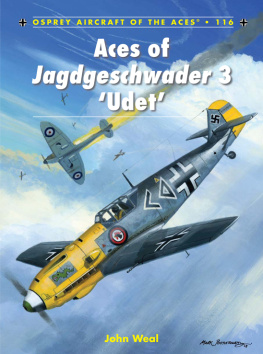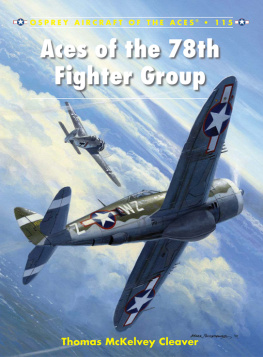| Aviation Elite Units 15 |  |
Jagdgeschwader 52
The Experten
John Weal
Series editor Tony Holmes
CONTENTS
FROM SMALL BEGINNINGS
T here are various ways of assessing the performance and effectiveness of a fighter unit. One famous fighter group is rightly proud of the fact that it did not lose a single one of its charges while engaged on bomber escort duties. Others can point with equal pride to their outstanding serviceability records, always being able to mount a maximum effort whenever called upon. Yet others can boast of completing operational tours with a minimum of combat casualties and exemplary kill-to-loss ratios.
But the commonest and most widely accepted measure of a fighter units success is the number of enemy machines it has shot down. And if this, admittedly rather simplistic, yardstick is applied, then one fighter formation towers head and shoulders above all the rest.
With well over 10,000 Allied aircraft destroyed during the course of World War 2, the Luftwaffes Jagdgeschwader 52 established a record not only unsurpassed in the annals of military aviation history to date, but one which seems likely to stand for all time.
Beyond the relatively narrow confines of the air war historian and enthusiast, however, the designation JG 52 remains little known. This may be due partly to the fact that the unit was never honoured with a title, or even given a popular name. The pilots of JG 52 were no Richthofen Circus or Abbeville Boys. Nor, for some reason, did their Winged Sword emblem enjoy the same widespread public recognition as, for example, JG 53s Ace-of-Spades insignia.
But the main reason for the general lack of acclaim accorded to this, the most successful fighter unit in the world, undoubtedly lies in the fact that for some two-thirds of its entire existence, JG 52 operated exclusively on the eastern front.
Many of its actions were fought over the vast, often tractless wastes of the Russian steppe, or above obscure villages and hamlets whose names are to be found on no modern map. And by far the overwhelming majority of its victims were machines hacked from the amorphous, and to this day still largely anonymous, ranks of the wartime Red Air Force.
Had JG 52 been employed on Reichs Defence duties over cities such as Berlin, Hamburg or Cologne, or had it defended western European airspace against incursions from some of the better known and more widely publicised RAF and USAAF fighter units and aces, then its story would no doubt have been very different indeed. But JG 52s history does at least have its roots in the west.
It began in November 1938 with the activation of a single Jagdgruppe at Ingolstadt-Manching, an airfield some 37 miles (60 km) due north of Munich. As its designation indicated, I./JG 433 was the first Gruppe of the fourth single-seat Jagdgeschwader to be formed within the area controlled by Luftwaffengruppenkommando 3 the territorial command which covered all of southern Germany.
The officer selected to lead the Gruppe was Hauptmann Dietrich Graf von Pfeil und Klein-Ellguth, who had commanded the provisional Fliegergruppe 10 during the Sudeten affair two months earlier.
The general easing of political tension throughout Europe in the immediate aftermath of the Sudeten crisis (which had been resolved by the signing of the Munich Agreement on 30 September 1938) was reflected in the slow, almost leisurely build-up of von Pfeils new Gruppe. Although practically a full complement of Bf 109Ds was delivered to Ingolstadt during December, less than a dozen pilots had been posted in by year-end.
This discrepancy in numbers became academic when a spell of unexpectedly severe weather descended on much of Bavaria during the Christmas period. Housed in two unheated hangars, nearly every single one of the Gruppes fighters was reportedly rendered unserviceable with their carburettor casings cracked as a result of the sharp overnight frosts.
Aircraft serviceability, and the weather, gradually improved during the opening weeks of 1939. New pilot intakes arrived fresh from training schools, and to assimilate these tyros and weld them into a cohesive whole von Pfeil was particularly fortunate in his appointed Staffelkapitne, all three of whom were experienced veterans of the Legion Condor. 2. and 3./JG 433 were commanded by Oberleutnants Wolfgang Ewald and Alfons Klein, respectively (each with a single victory claimed in Spain).
When first activated in 1938, I./JG 433 was initially equipped with Bf 109D-1s. This example provides a handy perch for a fully kitted-up Oberleutnant Lothar Ehrlich. Appointed Staffelkapitn of 8./JG 52 on 1 March 1940, Ehrlich was shot down off Margate on the opening day of III. Gruppes disastrous participation in the Battle of Britain
Another founder-member of I./JG 433, Hauptmann Wolfgang Ewald served as Kapitn of 2. Staffel for almost 22 months before assuming command of I./JG 52 in August 1940. He is seen here as a major, wearing the Knights Cross awarded to him in 1942 when Gruppenkommandeur of III./JG 3 on the eastern front
Heading 1. Staffel, von Pfeils senior Kapitn was a certain Oberleutnant Adolf Galland. A flyer with a passion for fighters, Galland had been forced to spend his recent tour with the Legion leading a ground-attack unit equipped with Heinkel He 51 biplanes (see Osprey Elite Units 13 - Luftwaffe Schlachtgruppen for further details). Returning from Spain, he had then been ordered to help organise the ad hoc ground-attack force being readied for possible action against the Czechs in the disputed Sudetenland. It was not until his subsequent posting to I./JG 433, effective as of 1 November 1938, that Adolf Galland felt he was at last back where he truly belonged at the controls of the Luftwaffes most advanced single-seat fighter.
On 18 February 1939 the Gruppe, still not yet at full strength, was dealt a tragic blow. While en route from Ingolstadt to Berlin, the units transport Ju 52/3m encountered a snowstorm over the Eger hills and crashed due to severe icing. All 11 occupants, passengers and crew, lost their lives. Among the dead was Oberleutnant Alfons Klein, who had purportedly hitched a lift on the ill-fated flight in order to visit the Berlin Motor Show.
For the next ten days 3./JG 433 operated under the caretaker leadership of Oberleutnant Karl-Heinz Leesmann until the arrival of Kleins official replacement on 1 March. Like his unfortunate predecessor, Oberleutnant Helmut Khle was also an ex-member of the Legion Condor.
March was to witness a number of other changes. Two further intakes of newly qualified pilots finally brought the Gruppe up to full establishment. The unit also took delivery of its first Bf 109Es (although it would not relinquish the last of its venerable Doras until July). And towards the end of the month moves were put in hand to transfer I./JG 433 to its new permanent station.
Next page















